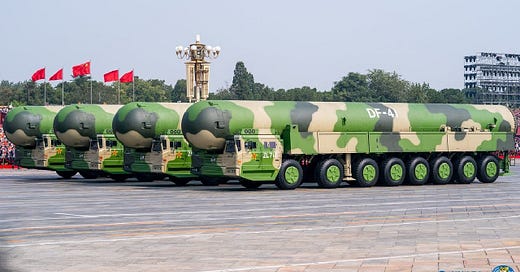Part I of this trilogy dealt with the foundations of China’s defense. This episode emphasizes its sophisticated, multi-layered composition and Corelli Barnett explains where real military power comes from. Part III explains how a hollowed-out US cannot even organize a credible military threat to China.
Hyperspectral detection satellites oversee the Western Pacific battlespace and airborne lasers detect waves and temperature variations generated by moving targets. The West Pacific Surveillance and Targeting satellite, along with fifteen Yaogan-30 satellites in low-earth orbit, operating as triplets positioned in close proximity, geo-locate military platforms by measuring the angular or time difference of arrival of their intercepted electromagnetic signals. Below them, the Caihong-T4, a massive, solar-powered drone, loiters for months at a cloudless altitude of sixty-five thousand feet, while below, the fifteen-ton, one-hundred fifty-foot wingspan Divine Eagle High Altitude Stealth-Hunting Drone reads electronic signals from aircraft long before they approach their targets.
Below the drones AWACS, whose solid-state detectors have twice the range of the US AWACS rotating domes, relay targeting information to Russian-built S-400 anti-aircraft/anti-missile batteries. Jin Canrong, the PRC’s senior defense policy advisor, says China has deployed weapons that can destroy in minutes every military base in its region, see all stealth bombers and submarines, and take out every aircraft carrier within two thousand miles of shore.
The DF-41 ICBM is a three-stage, solid-fuel device with a twelve-thousand mile range and a top speed of twenty-thousand mph. Road-mobile, it launches on four minutes warning and is faster, longer ranged than any Western weapon and delivers ten independently targetable nuclear warheads.
The DF-ZF Hypersonic Glide Vehicle, whose significance Russian Defense Minister Rogozin compared to the atom bomb, began its deployment cycle in 2023. Launched sixty miles above the earth from a missile traveling at sixteen-thousand mph, the DF-ZF rides its own supersonic shockwave to the target. Says RAND, “With the ability to fly at unpredictable trajectories, these missiles will hold extremely large areas at risk throughout much of their flight”. A Congressional report concludes, “The very high speeds of these weapons combined with their maneuverability and ability to travel at lower, radar-evading altitudes would make them far less vulnerable to current defenses than existing missiles”.
In real wars, boots on the ground determine final outcomes and the PLA is as unconventional as its weapons. Combat forces elect their NCOs and all two-million soldiers receive more political education than the rest of the world’s troops combined, as historian William Hinton explains, “From its inception the Army has been led by the Party and has never played a purely military role. On the contrary, Army cadres have always played a leading political role”. Mao explained, “The Red Army fights not merely for the sake of fighting but in order to conduct propaganda, xuānchuán, among the people, organize, arm and help them establish revolutionary political power. Without these objectives, fighting loses its meaning and the Red Army loses its reason for existence”. Xiaoming Zhang adds, “Under the influence of Confucian philosophy, the concept of the just or righteous war was prevalent throughout Chinese society so, unlike Western militaries which depend on professional ethics and training to ensure that soldiers perform their duties in war, the PLA opted for political indoctrination and attempted to make troops understand why a war must be fought and how it would matter to them”.
By coordinating its military, legal, diplomatic, and economic assets simultaneously, China exemplifies Correlli Barnett’s dictum:
The power of a nation-state by no means consists only in its armed forces, but also in its economic and technological resources; in the dexterity, foresight and resolution with which its foreign policy is conducted; in the efficiency of its social and political organization. It consists most of all in the nation itself: the people; their skills, energy, ambition, discipline, initiative; their beliefs, myths and illusions. And it consists, further, in the way all these factors are related to one another. Moreover, national power has to be considered not only in itself, in its absolute extent, but relative to the state’s foreign or imperial obligations; it has to be considered relative to the power of other states.
If it has not already done so, China’s military budget will reach nominal currency parity with America’s in 2028. Oon that day, seventy years of Chinese anxiety and American hegemony will come to a peaceful end. We hope.





One small correction, Godfrey, Dmitri Rogozin was never the Russian Defence Minister. He has served as the Russian ambassador to NATO, Deputy Prime Minister of Russia and Head of Roscosmos.